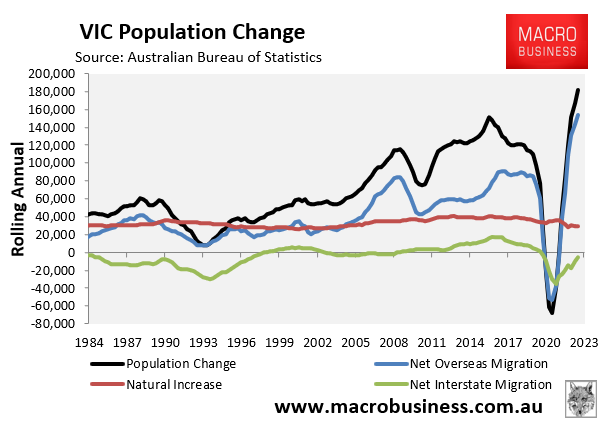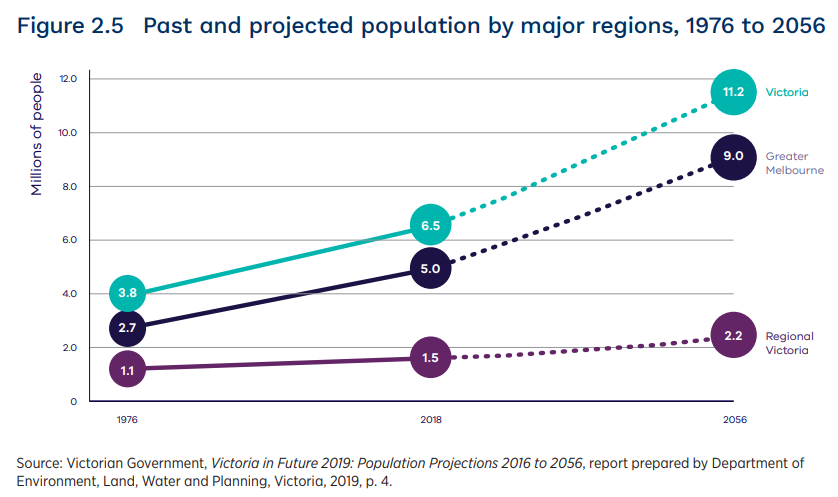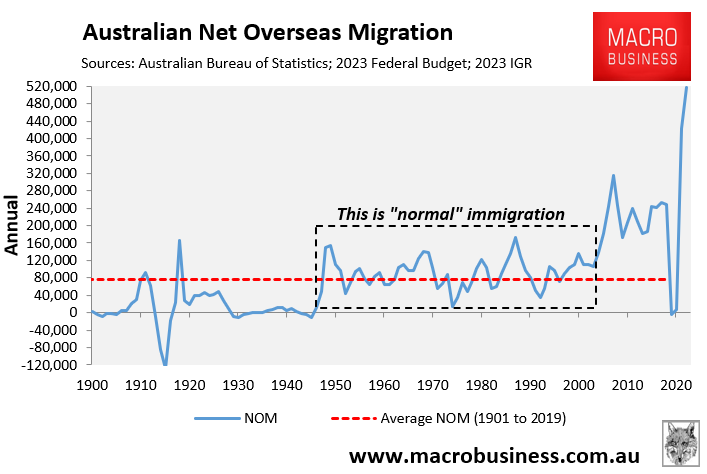Shortly before resigning as Victorian Premier, Daniel Andrews announced a target to build 800,000 homes across the state over a decade, which requires 80,000 homes annually.
Victoria has never approved more than 70,730 new dwellings in a calendar year since Labor was elected in 2014, meaning the 80,000 target requires a significant step-up in construction activity.
However, the figures are going the wrong way.
Victoria’s dwelling approvals have collapsed, with only 51,000 homes approved for construction in 2023, 29,000 below the 80,000 target:

This represents the lowest annual dwelling approval figures for Victoria in a decade.
The collapse in construction has come at the same time as the state’s population is growing at a record pace, with 182,000 people landing in Victoria in 2022-23, 154,000 via net overseas migration:

Property industry insiders are not hopeful that Victoria can meet its housing target.
REIV director Richard Simpson told The AFR that “difficulties of obtaining suitable land, as well as the supply constraints on labour and building materials” will render the targets unachievable.
Simpson added that the problem is “being turbocharged by the fact we’ve got a significant inflow of migrants to Australia, many of whom are coming to Victoria. They need somewhere to live”.
Opposition housing spokesman, Evan Mulholland, rightly labelled Labor’s 80,000 homes target a “con job”.
“That is not achievable in the slightest”, he said. “The target just gives the illusion of doing something”.
The Victorian government is also failing its $5.3 billion Big Housing Build social housing program.
This program promised to deliver 12,000 new social and affordable homes throughout the state.
However, three years and four months on, just over 9000 of those homes were complete or in construction, according to 9News.
“The $5.3 billion scheme set out to build 9300 new homes and replace 1100 of existing public housing”.
“Just 3611 homes are finished”.
“In the middle of 2020, Victoria had a little over 85,111 public and social homes”.
“Three years later, the state had 88,189, an increase of just 3.6 per cent but that figure shrinks to just 1.6 per cent if you compare today’s number to 2018″…
“There are now 3500 public houses with fewer bedrooms in Victoria compared to 2017”.
“At the same time, the waitlist for public and social housing has almost doubled from 35,392 applications to 60,708”.
No wonder that Victoria is ground zero in Australia’s homelessness crisis with the lowest share of public and social housing in Australia.
Demand for housing has rocketed due to net overseas migration, while the supply of housing stalls.
Worse, the Victorian government projects that the state’s population will swell to 11.2 million people by 2056, with Melbourne to grow to 9.0 million:

The overwhelming majority of Victoria’s population growth is projected to come from net overseas migration:

As a result, Victorians face ongoing housing shortages, with the population forever outpacing supply.
The notion that Victoria can build 80,000 homes every year for ten years is unrealistic.
It is even more delusional when the state government has devoted the majority of the state’s construction resources to its Big Build infrastructure projects, which will eat up available personnel, equipment, and materials.
The only realistic solution for Victoria’s (and Australia’s) housing crisis is for the federal government to cut net overseas migration to sensible and sustainable levels of less than 120,000 a year.

Otherwise, the problems will compound.

